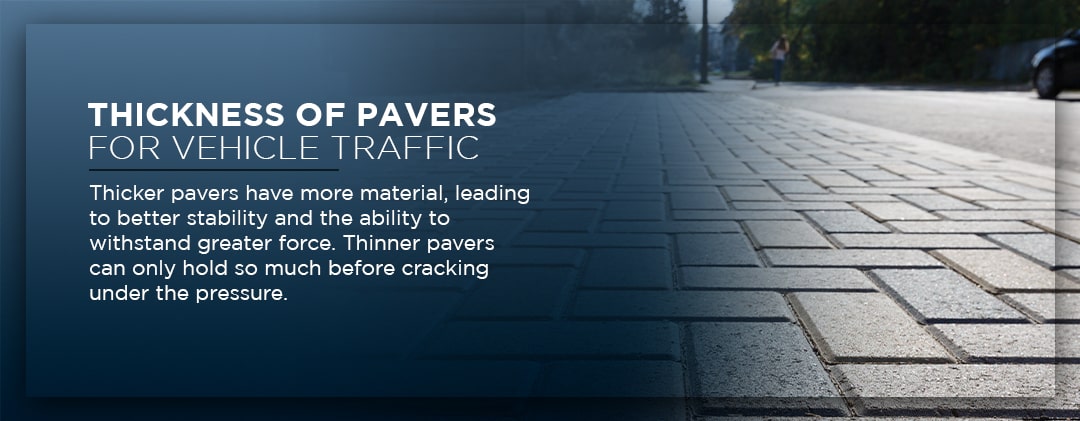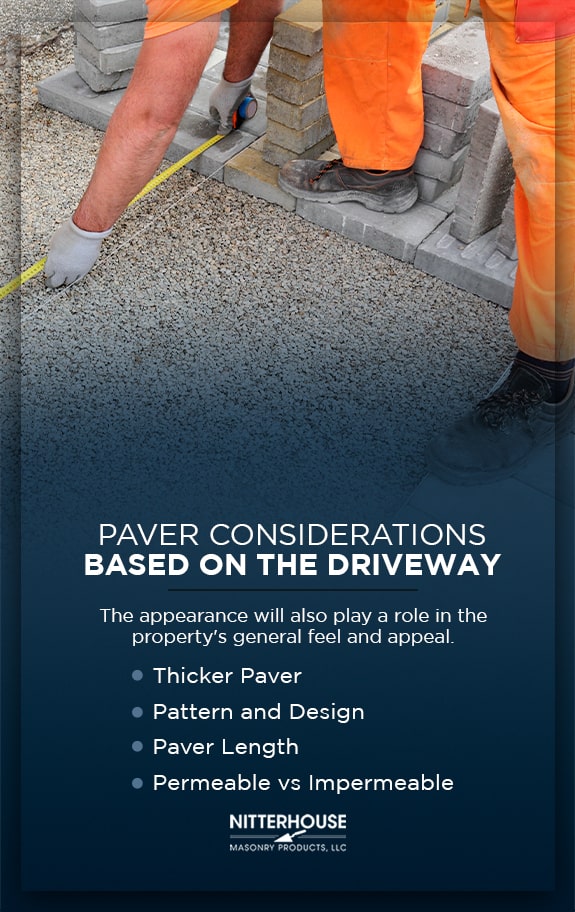
Jump To:
- What Makes Pavers Safe for Vehicle Traffic?
- Thickness of Pavers for Vehicle Traffic
- Do Pavers Break When You Drive on Them?
- Paver Considerations Based on the Driveway
- Paver Installation Considerations for Vehicle Traffic
- Nitterhouse Concrete Pavers
When creating driveways, entryways and other paved surfaces for vehicles, you have several options. There’s gravel, but it’s not very attractive, not to mention loose and messy. The rocks can spread far from their original spot and are tougher on vehicles. There’s also poured concrete, which is more stable, durable and smoother than gravel. But concrete doesn’t perform well in extreme temperature shifts. It doesn’t have room for expansion and contraction, so cracks are likely. Over a long period, poured concrete also has a harder time withstanding heavier vehicle pressure.
That leaves pavers. While they might not seem particularly sturdy at first, pavers are perfectly capable of handling vehicles and various environmental extremes. They are the perfect medium to create a visually appealing and durable surface that’s well-suited to vehicles and high-traffic environments, even heavy maintenance vehicles and trucks. Pavers provide a charming visual contrast and can increase property value, from homes and apartments to hotels and office buildings.
However, choosing the correct width, thickness and length can be an intimidating process, especially for those new to the product. Whether you’re looking to add them to your home or to a client’s property, selecting the right pavers is a crucial part of the job. Let’s break down the different components so you can make an informed choice.
What Makes Pavers Safe for Vehicle Traffic?
Pavers provide a stable and reliable pathway for vehicles, but at first glance, they may not seem like the most durable or reliable option for a driveway or walkway. Each paver appears unable to handle vehicular traffic, but when placed together with the appropriate thickness, size and pattern, pavers become a pathway that is four times stronger than concrete.

Thickness of Pavers for Vehicle Traffic
The higher the vehicle traffic, the thicker the paver you will want. Thicker pavers have more material, leading to better stability and the ability to withstand greater force. Thinner pavers can only hold so much before cracking under the pressure.
In general, you should use thicker pavers for all forms of vehicle traffic, even if only one car will be driving over them.
Do Pavers Break When You Drive on Them?
When installed correctly, pavers should not break under typical traffic levels. Pavers are the longest-lasting driveway option. So what causes them to occasionally crack, sink or shift? More than likely, it’s either due to improper installation or choosing the wrong pavers for the job. When these issues occur, the reason is usually a result of a poor subbase or bedding sand for the amount of traffic pressure.
As people drive over the pavers, the vehicle’s weight presses down and can cause breakage. If the pavers are too thin, they can flip and pull up as the vehicles move over them. That’s why it’s so critical to know your stuff or work with paving experts when building a long-lasting driving surface.
Material
The type of material you choose for your pavers can also affect the driveway’s quality and durability. While there are many different types of materials to choose from, you should avoid porcelain, marble, travertine and cobblestone for driveway usage.
All four of these are extremely fragile and will break easily under the strain of a vehicle or even foot traffic. Unless you can afford to constantly replace the pieces that break, these materials are not worth the effort.
A better choice is to use extra-durable concrete pavers. These pavers are a great stylistic choice with an easy install, and they come in various colors. Concrete pavers offer many different design options to choose from and a range of benefits, like high durability, low maintenance costs and wind, water and heat resistance.
The reason is that pavers are smaller and more compact. The gaps between each one allow the pavers to easily expand, contract and distribute or transfer the pressure. When chosen correctly, each paver will be sturdy enough to resist the stress of vehicles without allowing shifting or cracking.
Another common issue with driving surfaces is the unpredictable effects of weather. You want a driveway that can withstand temperature shifts. In extreme weather changes, poured concrete can break, as it does not have any room to expand and contract. Each slab is large, wide and confined to a tight area. The space between pavers safely allows each one to expand as necessary without interfering with the others.

Paver Considerations Based on the Driveway
When choosing a paver for a driveway, you will want one that can accommodate the amount of traffic the pavers will see. For standard residential usage — cars, trucks and maybe some heavy transport vehicles — you will need to pick a paver with the right thickness, pattern design and length. You will also need to consider whether you want a permeable or impermeable driveway.
Commercial applications will call for the same considerations, but they need to be especially stable to prevent liability concerns. The appearance will also play a role in the property’s general feel and appeal.
Thicker Paver
A thicker paver is a must in preventing cracking or chipping as vehicles drive on them. To determine the necessary thickness for your project, our rule of thumb is to calculate the paver’s aspect ratio. Divide the paver’s longest dimension by its thickness. If this ratio is less than four, it’s not suitable for driving.
For example, if you want to use an 18″ x 24″ x 1-7/8″ paver, you would divide 24 by 1-7/8. That gives us 12.8, much larger than four, so it’s too thin for driving. However, if you were also considering a 6″ x 12″ x 3″ paver, you’d end up with 12 divided by 3. That gives us four, which should be suitable for driving.
You may also consider installing a geo-fabric layer to add extra protection against shifting.
Pattern and Design
Pavers have no shortage of patterns, shapes, colors and sizes to choose from. From regal to rustic, you can use pavers to match and support just about any look for a property and create unique designs. At Nitterhouse Masonry, we can even customize your pavers to suit the job.
Patterns can include basic stack bonds, herringbone patterns, ashlar stacks and many others. Each pattern comes with varying levels of strength based on the way the pavers interlock, so be sure to talk this over with a paving pro. The pattern’s scale will also affect the paver’s appearance and functionality.
If you wish to do a more fanciful design, such as adding a floral image that disrupts the pattern, it is strongly recommended to keep those for low-traffic areas. Disrupting the pattern can lead to a greater risk of breaking for high-traffic areas. The pavers have a harder time distributing the pressure among themselves.
Paver Length
When you drive over a paver, the weight of the vehicle pushes down on it. Each paver tries to distribute as much pressure as it can. The longer and wider the paver, the lower the amount of pressure it can withstand. Flexural strength is the technical term for the amount of strain a material can withstand before it breaks.
Permeable vs. Impermeable
Like the names suggest, the difference between permeable and impermeable paver configurations is the ability to allow water to flow through the pavers.
Impermeable paver systems resist water from flowing underneath them. They usually have a coating that keeps the water pooled on the surface. At first glance, impermeable systems seem to be the best option for keeping the pavers safe from cracking and shifting. No water can get between the layers and damage the foundation.
While that may be true, impermeable pavers can have specific safety risks. If you live in an area prone to rain, snowfall or temperatures that fall below freezing, the surface might be less safe. The pooled water reduces traction for wheels and can turn into ice.
On the other hand, permeable paver systems allow water to flow through the pavers and into a drainage system underneath. The drainage system prevents water from pooling on the surface by adding a rock layer underneath the pavers. This layer has proven to help reduce the burden of stormwater collection systems and decrease the number of pollutants in the local water. For extra safety, permeable pavers also allow for a heating pad underneath the pavers. It keeps them from remaining wet and potentially freezing.
Paver Installation Considerations for Vehicle Traffic
Installing a paver driveway can either be a straightforward process or a complicated one, depending on the type of set and bonding you use. In addition to being the most common installation process for pavers, sand set is also the cheapest and quickest option available. First, installers set pavers on a level bed of sand. Then, they pour more sand between the pavers for increased stability and support. It’s possible to install drainage systems underneath, and some sands harden with moisture, allowing for a faster set time.
Sand-set pavers have a difficult time remaining set around the edges. Constant upkeep is necessary to keep the pavers level and in place. Without maintenance, the sand will begin to shift or sink over time with vehicular traffic. However, with the proper installation, pavers on a sand setting bed will give a long-lasting surface.

Nitterhouse Concrete Pavers
Nitterhouse Masonry Products is a family-owned business that has been around for more than 100 years. We know concrete and how to make it right. Our concrete pavers come in various options, depending on your intended usage. We have architectural paving stones in many sizes and colors to suit your projects. At Nitterhouse, we pride ourselves on our ability to offer concrete pavers to fit whatever need you may have.
Our newest paver style, Urban Stone, offers the perfect combination of guaranteed commercial usage and luxury. These pavers hold up excellently to vehicle traffic because of their versatile size of 6″ x 12″ and a thickness of 3-1/8″. We created Urban Stone with the promise of a more durable and longer-lasting paver. We manufacture each with superior-quality concrete strength, allowing it to withstand vehicle traffic.
Urban Stone also comes in over 30 different colors you can mix and match to increase any property’s curb appeal and bring your creative vision to life.

Contact Nitterhouse Masonry for Vehicular Pavers
Pavers are an excellent choice for driveways and entryways. They are safer for vehicles, more durable and require less maintenance overall. They also allow for a more unique driveway in terms of pattern and color when compared to concrete or gravel.
If you’re still at a loss on where to begin, getting extra assistance is as easy as calling us at 717-267-4500. We will be happy to offer more information on all of our paver options. If you don’t have time for a phone call, you can easily fill out an online form. Provide the necessary information for the project type and any details you already know, and a paving expert will contact you to help answer any further questions and get you started on your project.
You can never go wrong with a paver driveway. Make the switch and find yourself enjoying simplicity and easy maintenance today!


